TESCO Business Environment Analysis: SWOT/TOWS and Macro Factors
VerifiedAdded on 2020/07/22
|9
|2045
|143
Report
AI Summary
This report provides a comprehensive analysis of TESCO's business environment. It begins with an introduction to the concept of the business environment, emphasizing the influence of internal and external factors. The report then delves into the impact of macro-environmental factors (political, economic, social, technological, legal, and environmental) on TESCO's operations, highlighting both positive and negative effects. A key component of the analysis is a SWOT/TOWS matrix, evaluating TESCO's strengths, weaknesses, opportunities, and threats, and how these factors interrelate to formulate strategic responses. The report also examines how TESCO can leverage its strengths to mitigate weaknesses and capitalize on opportunities while mitigating threats. The conclusion summarizes the findings and emphasizes the importance of understanding the business environment for effective decision-making and operational success. The report references various academic sources to support its analysis.
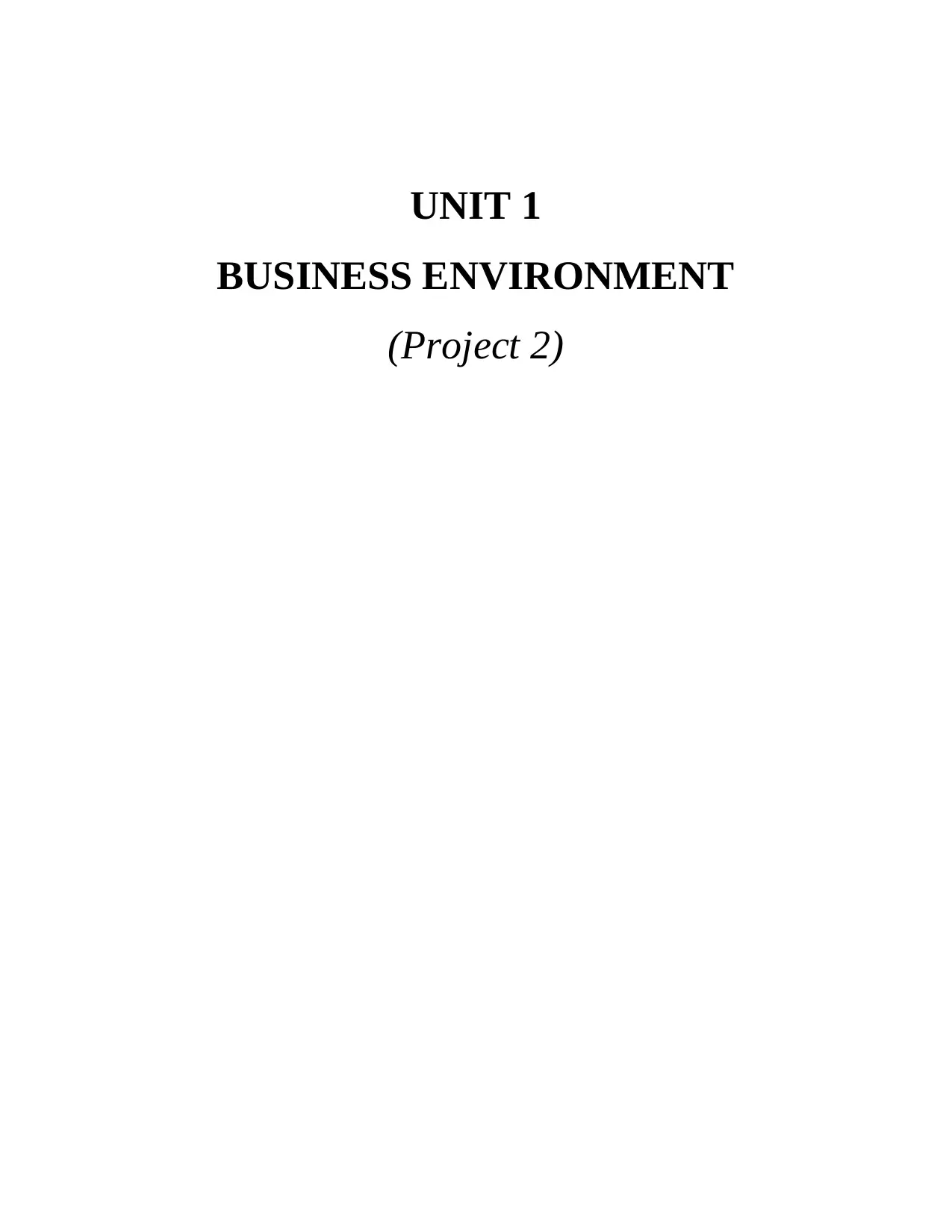
UNIT 1
BUSINESS ENVIRONMENT
(Project 2)
BUSINESS ENVIRONMENT
(Project 2)
Paraphrase This Document
Need a fresh take? Get an instant paraphrase of this document with our AI Paraphraser
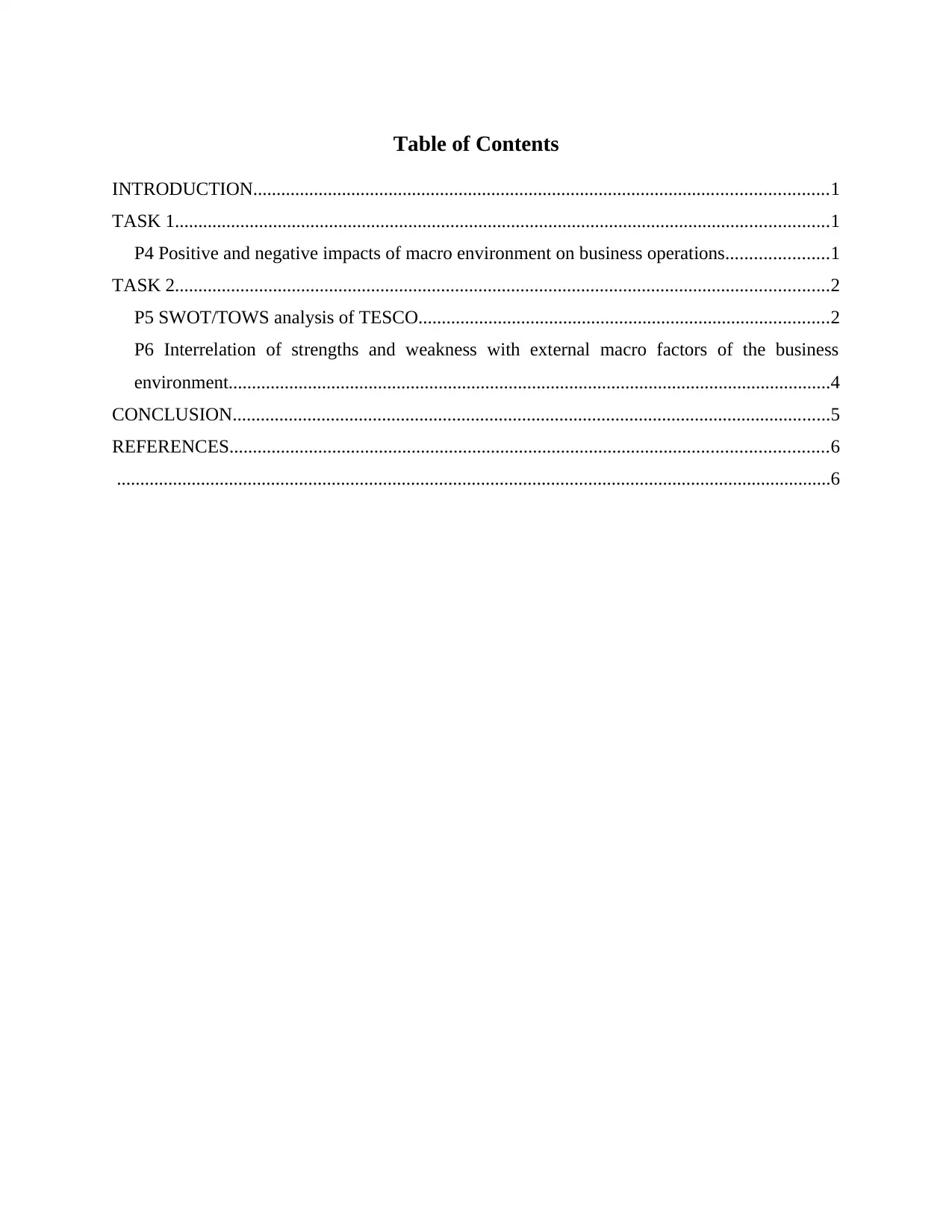
Table of Contents
INTRODUCTION...........................................................................................................................1
TASK 1............................................................................................................................................1
P4 Positive and negative impacts of macro environment on business operations......................1
TASK 2............................................................................................................................................2
P5 SWOT/TOWS analysis of TESCO........................................................................................2
P6 Interrelation of strengths and weakness with external macro factors of the business
environment.................................................................................................................................4
CONCLUSION................................................................................................................................5
REFERENCES................................................................................................................................6
.........................................................................................................................................................6
INTRODUCTION...........................................................................................................................1
TASK 1............................................................................................................................................1
P4 Positive and negative impacts of macro environment on business operations......................1
TASK 2............................................................................................................................................2
P5 SWOT/TOWS analysis of TESCO........................................................................................2
P6 Interrelation of strengths and weakness with external macro factors of the business
environment.................................................................................................................................4
CONCLUSION................................................................................................................................5
REFERENCES................................................................................................................................6
.........................................................................................................................................................6
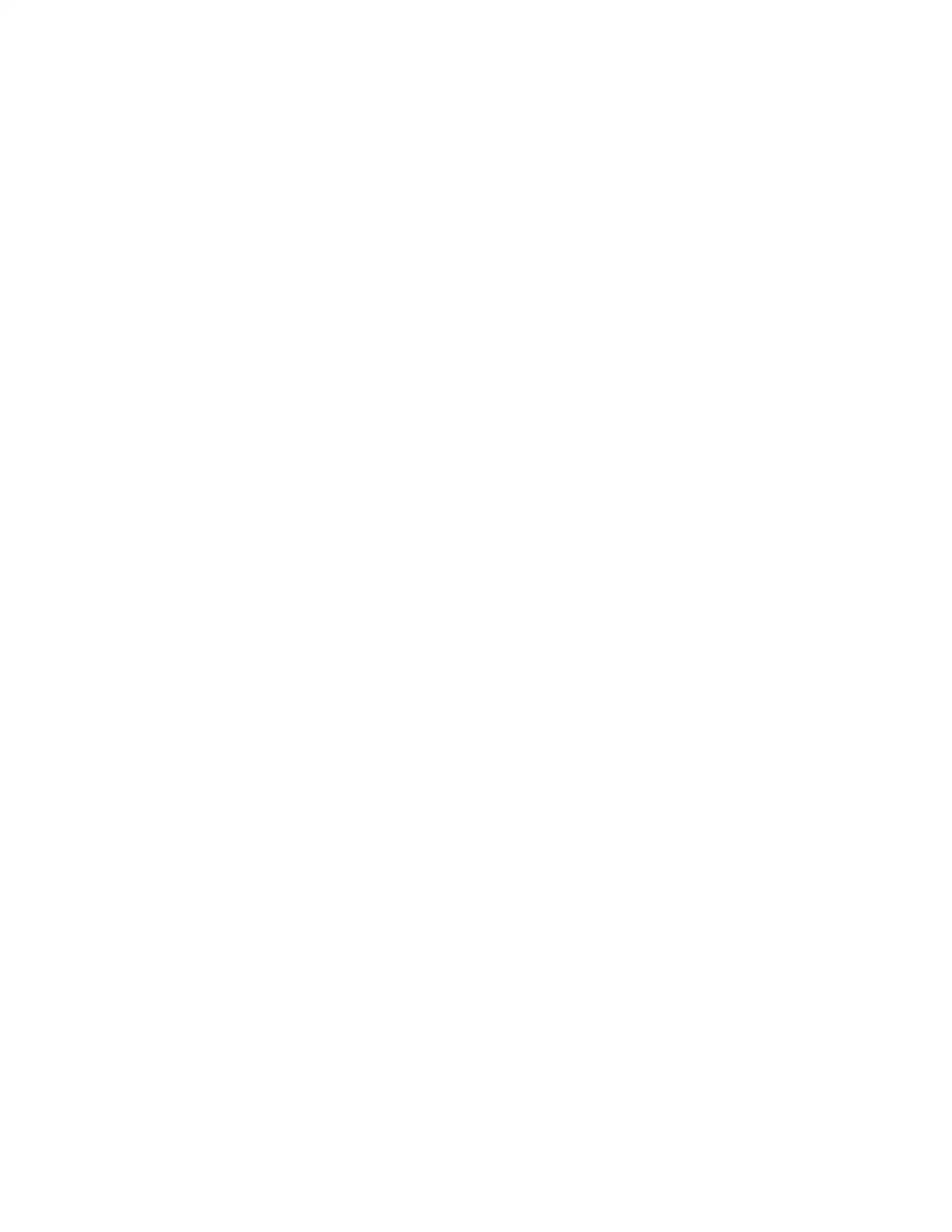
⊘ This is a preview!⊘
Do you want full access?
Subscribe today to unlock all pages.

Trusted by 1+ million students worldwide
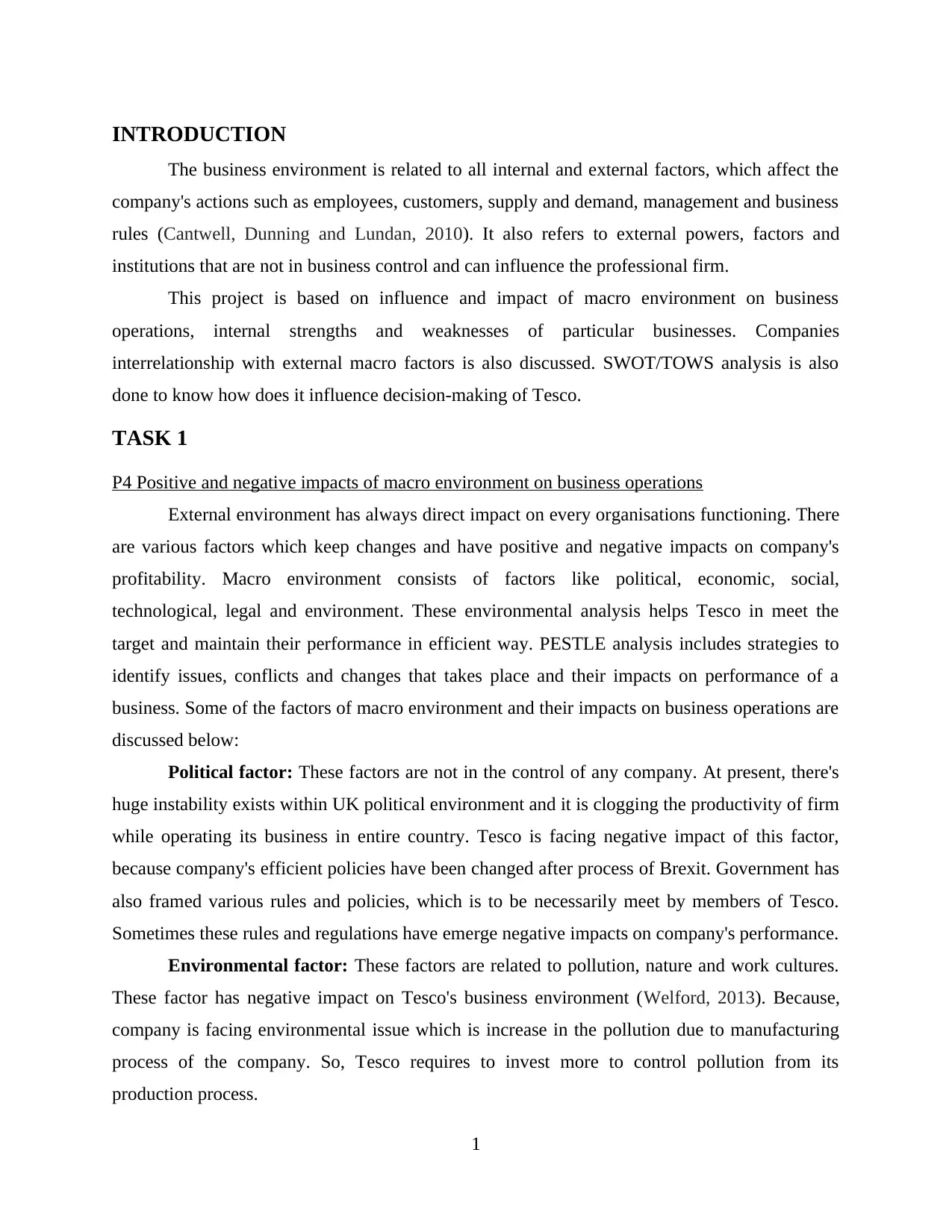
INTRODUCTION
The business environment is related to all internal and external factors, which affect the
company's actions such as employees, customers, supply and demand, management and business
rules (Cantwell, Dunning and Lundan, 2010). It also refers to external powers, factors and
institutions that are not in business control and can influence the professional firm.
This project is based on influence and impact of macro environment on business
operations, internal strengths and weaknesses of particular businesses. Companies
interrelationship with external macro factors is also discussed. SWOT/TOWS analysis is also
done to know how does it influence decision-making of Tesco.
TASK 1
P4 Positive and negative impacts of macro environment on business operations
External environment has always direct impact on every organisations functioning. There
are various factors which keep changes and have positive and negative impacts on company's
profitability. Macro environment consists of factors like political, economic, social,
technological, legal and environment. These environmental analysis helps Tesco in meet the
target and maintain their performance in efficient way. PESTLE analysis includes strategies to
identify issues, conflicts and changes that takes place and their impacts on performance of a
business. Some of the factors of macro environment and their impacts on business operations are
discussed below:
Political factor: These factors are not in the control of any company. At present, there's
huge instability exists within UK political environment and it is clogging the productivity of firm
while operating its business in entire country. Tesco is facing negative impact of this factor,
because company's efficient policies have been changed after process of Brexit. Government has
also framed various rules and policies, which is to be necessarily meet by members of Tesco.
Sometimes these rules and regulations have emerge negative impacts on company's performance.
Environmental factor: These factors are related to pollution, nature and work cultures.
These factor has negative impact on Tesco's business environment (Welford, 2013). Because,
company is facing environmental issue which is increase in the pollution due to manufacturing
process of the company. So, Tesco requires to invest more to control pollution from its
production process.
1
The business environment is related to all internal and external factors, which affect the
company's actions such as employees, customers, supply and demand, management and business
rules (Cantwell, Dunning and Lundan, 2010). It also refers to external powers, factors and
institutions that are not in business control and can influence the professional firm.
This project is based on influence and impact of macro environment on business
operations, internal strengths and weaknesses of particular businesses. Companies
interrelationship with external macro factors is also discussed. SWOT/TOWS analysis is also
done to know how does it influence decision-making of Tesco.
TASK 1
P4 Positive and negative impacts of macro environment on business operations
External environment has always direct impact on every organisations functioning. There
are various factors which keep changes and have positive and negative impacts on company's
profitability. Macro environment consists of factors like political, economic, social,
technological, legal and environment. These environmental analysis helps Tesco in meet the
target and maintain their performance in efficient way. PESTLE analysis includes strategies to
identify issues, conflicts and changes that takes place and their impacts on performance of a
business. Some of the factors of macro environment and their impacts on business operations are
discussed below:
Political factor: These factors are not in the control of any company. At present, there's
huge instability exists within UK political environment and it is clogging the productivity of firm
while operating its business in entire country. Tesco is facing negative impact of this factor,
because company's efficient policies have been changed after process of Brexit. Government has
also framed various rules and policies, which is to be necessarily meet by members of Tesco.
Sometimes these rules and regulations have emerge negative impacts on company's performance.
Environmental factor: These factors are related to pollution, nature and work cultures.
These factor has negative impact on Tesco's business environment (Welford, 2013). Because,
company is facing environmental issue which is increase in the pollution due to manufacturing
process of the company. So, Tesco requires to invest more to control pollution from its
production process.
1
Paraphrase This Document
Need a fresh take? Get an instant paraphrase of this document with our AI Paraphraser
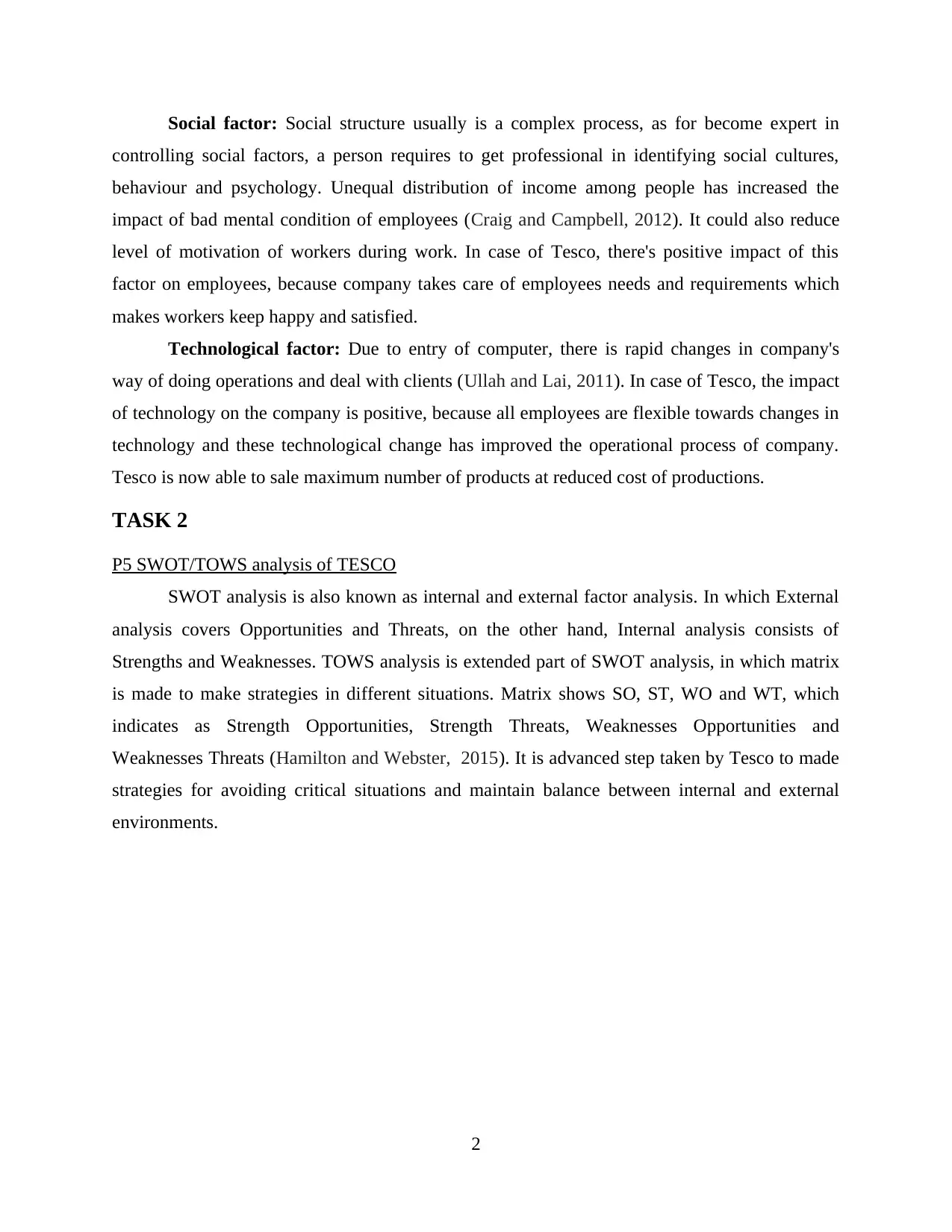
Social factor: Social structure usually is a complex process, as for become expert in
controlling social factors, a person requires to get professional in identifying social cultures,
behaviour and psychology. Unequal distribution of income among people has increased the
impact of bad mental condition of employees (Craig and Campbell, 2012). It could also reduce
level of motivation of workers during work. In case of Tesco, there's positive impact of this
factor on employees, because company takes care of employees needs and requirements which
makes workers keep happy and satisfied.
Technological factor: Due to entry of computer, there is rapid changes in company's
way of doing operations and deal with clients (Ullah and Lai, 2011). In case of Tesco, the impact
of technology on the company is positive, because all employees are flexible towards changes in
technology and these technological change has improved the operational process of company.
Tesco is now able to sale maximum number of products at reduced cost of productions.
TASK 2
P5 SWOT/TOWS analysis of TESCO
SWOT analysis is also known as internal and external factor analysis. In which External
analysis covers Opportunities and Threats, on the other hand, Internal analysis consists of
Strengths and Weaknesses. TOWS analysis is extended part of SWOT analysis, in which matrix
is made to make strategies in different situations. Matrix shows SO, ST, WO and WT, which
indicates as Strength Opportunities, Strength Threats, Weaknesses Opportunities and
Weaknesses Threats (Hamilton and Webster, 2015). It is advanced step taken by Tesco to made
strategies for avoiding critical situations and maintain balance between internal and external
environments.
2
controlling social factors, a person requires to get professional in identifying social cultures,
behaviour and psychology. Unequal distribution of income among people has increased the
impact of bad mental condition of employees (Craig and Campbell, 2012). It could also reduce
level of motivation of workers during work. In case of Tesco, there's positive impact of this
factor on employees, because company takes care of employees needs and requirements which
makes workers keep happy and satisfied.
Technological factor: Due to entry of computer, there is rapid changes in company's
way of doing operations and deal with clients (Ullah and Lai, 2011). In case of Tesco, the impact
of technology on the company is positive, because all employees are flexible towards changes in
technology and these technological change has improved the operational process of company.
Tesco is now able to sale maximum number of products at reduced cost of productions.
TASK 2
P5 SWOT/TOWS analysis of TESCO
SWOT analysis is also known as internal and external factor analysis. In which External
analysis covers Opportunities and Threats, on the other hand, Internal analysis consists of
Strengths and Weaknesses. TOWS analysis is extended part of SWOT analysis, in which matrix
is made to make strategies in different situations. Matrix shows SO, ST, WO and WT, which
indicates as Strength Opportunities, Strength Threats, Weaknesses Opportunities and
Weaknesses Threats (Hamilton and Webster, 2015). It is advanced step taken by Tesco to made
strategies for avoiding critical situations and maintain balance between internal and external
environments.
2
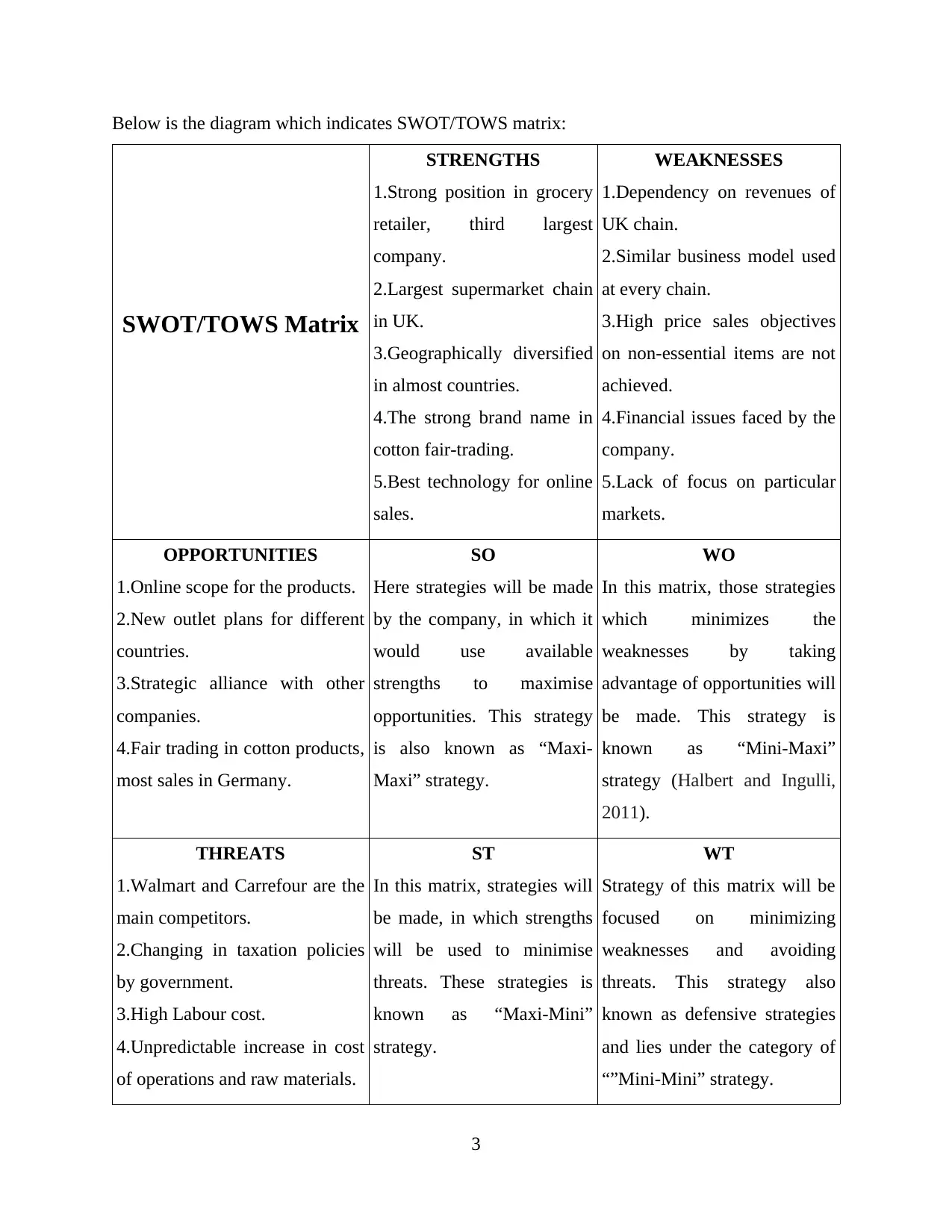
Below is the diagram which indicates SWOT/TOWS matrix:
SWOT/TOWS Matrix
STRENGTHS
1.Strong position in grocery
retailer, third largest
company.
2.Largest supermarket chain
in UK.
3.Geographically diversified
in almost countries.
4.The strong brand name in
cotton fair-trading.
5.Best technology for online
sales.
WEAKNESSES
1.Dependency on revenues of
UK chain.
2.Similar business model used
at every chain.
3.High price sales objectives
on non-essential items are not
achieved.
4.Financial issues faced by the
company.
5.Lack of focus on particular
markets.
OPPORTUNITIES
1.Online scope for the products.
2.New outlet plans for different
countries.
3.Strategic alliance with other
companies.
4.Fair trading in cotton products,
most sales in Germany.
SO
Here strategies will be made
by the company, in which it
would use available
strengths to maximise
opportunities. This strategy
is also known as “Maxi-
Maxi” strategy.
WO
In this matrix, those strategies
which minimizes the
weaknesses by taking
advantage of opportunities will
be made. This strategy is
known as “Mini-Maxi”
strategy (Halbert and Ingulli,
2011).
THREATS
1.Walmart and Carrefour are the
main competitors.
2.Changing in taxation policies
by government.
3.High Labour cost.
4.Unpredictable increase in cost
of operations and raw materials.
ST
In this matrix, strategies will
be made, in which strengths
will be used to minimise
threats. These strategies is
known as “Maxi-Mini”
strategy.
WT
Strategy of this matrix will be
focused on minimizing
weaknesses and avoiding
threats. This strategy also
known as defensive strategies
and lies under the category of
“”Mini-Mini” strategy.
3
SWOT/TOWS Matrix
STRENGTHS
1.Strong position in grocery
retailer, third largest
company.
2.Largest supermarket chain
in UK.
3.Geographically diversified
in almost countries.
4.The strong brand name in
cotton fair-trading.
5.Best technology for online
sales.
WEAKNESSES
1.Dependency on revenues of
UK chain.
2.Similar business model used
at every chain.
3.High price sales objectives
on non-essential items are not
achieved.
4.Financial issues faced by the
company.
5.Lack of focus on particular
markets.
OPPORTUNITIES
1.Online scope for the products.
2.New outlet plans for different
countries.
3.Strategic alliance with other
companies.
4.Fair trading in cotton products,
most sales in Germany.
SO
Here strategies will be made
by the company, in which it
would use available
strengths to maximise
opportunities. This strategy
is also known as “Maxi-
Maxi” strategy.
WO
In this matrix, those strategies
which minimizes the
weaknesses by taking
advantage of opportunities will
be made. This strategy is
known as “Mini-Maxi”
strategy (Halbert and Ingulli,
2011).
THREATS
1.Walmart and Carrefour are the
main competitors.
2.Changing in taxation policies
by government.
3.High Labour cost.
4.Unpredictable increase in cost
of operations and raw materials.
ST
In this matrix, strategies will
be made, in which strengths
will be used to minimise
threats. These strategies is
known as “Maxi-Mini”
strategy.
WT
Strategy of this matrix will be
focused on minimizing
weaknesses and avoiding
threats. This strategy also
known as defensive strategies
and lies under the category of
“”Mini-Mini” strategy.
3
⊘ This is a preview!⊘
Do you want full access?
Subscribe today to unlock all pages.

Trusted by 1+ million students worldwide
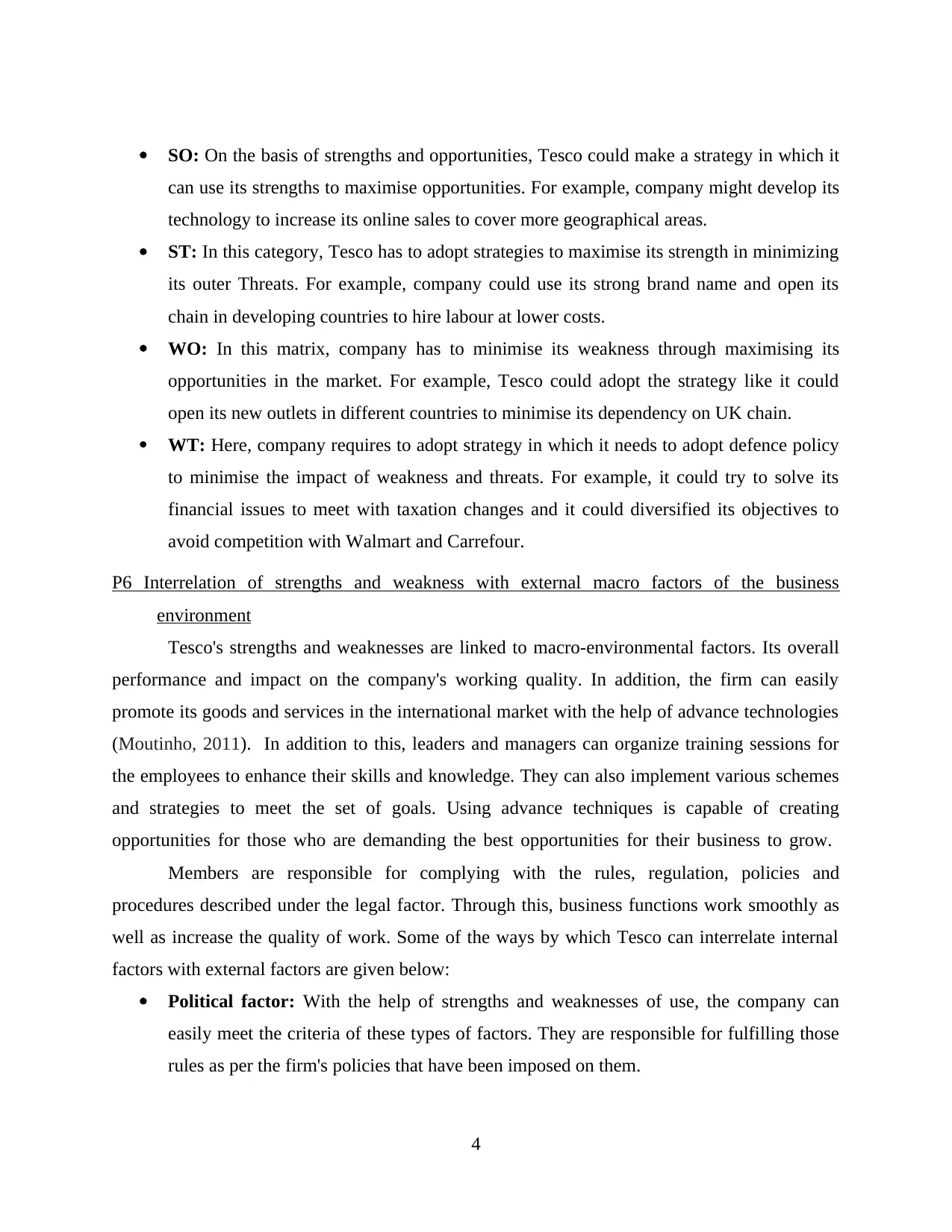
SO: On the basis of strengths and opportunities, Tesco could make a strategy in which it
can use its strengths to maximise opportunities. For example, company might develop its
technology to increase its online sales to cover more geographical areas.
ST: In this category, Tesco has to adopt strategies to maximise its strength in minimizing
its outer Threats. For example, company could use its strong brand name and open its
chain in developing countries to hire labour at lower costs.
WO: In this matrix, company has to minimise its weakness through maximising its
opportunities in the market. For example, Tesco could adopt the strategy like it could
open its new outlets in different countries to minimise its dependency on UK chain.
WT: Here, company requires to adopt strategy in which it needs to adopt defence policy
to minimise the impact of weakness and threats. For example, it could try to solve its
financial issues to meet with taxation changes and it could diversified its objectives to
avoid competition with Walmart and Carrefour.
P6 Interrelation of strengths and weakness with external macro factors of the business
environment
Tesco's strengths and weaknesses are linked to macro-environmental factors. Its overall
performance and impact on the company's working quality. In addition, the firm can easily
promote its goods and services in the international market with the help of advance technologies
(Moutinho, 2011). In addition to this, leaders and managers can organize training sessions for
the employees to enhance their skills and knowledge. They can also implement various schemes
and strategies to meet the set of goals. Using advance techniques is capable of creating
opportunities for those who are demanding the best opportunities for their business to grow.
Members are responsible for complying with the rules, regulation, policies and
procedures described under the legal factor. Through this, business functions work smoothly as
well as increase the quality of work. Some of the ways by which Tesco can interrelate internal
factors with external factors are given below:
Political factor: With the help of strengths and weaknesses of use, the company can
easily meet the criteria of these types of factors. They are responsible for fulfilling those
rules as per the firm's policies that have been imposed on them.
4
can use its strengths to maximise opportunities. For example, company might develop its
technology to increase its online sales to cover more geographical areas.
ST: In this category, Tesco has to adopt strategies to maximise its strength in minimizing
its outer Threats. For example, company could use its strong brand name and open its
chain in developing countries to hire labour at lower costs.
WO: In this matrix, company has to minimise its weakness through maximising its
opportunities in the market. For example, Tesco could adopt the strategy like it could
open its new outlets in different countries to minimise its dependency on UK chain.
WT: Here, company requires to adopt strategy in which it needs to adopt defence policy
to minimise the impact of weakness and threats. For example, it could try to solve its
financial issues to meet with taxation changes and it could diversified its objectives to
avoid competition with Walmart and Carrefour.
P6 Interrelation of strengths and weakness with external macro factors of the business
environment
Tesco's strengths and weaknesses are linked to macro-environmental factors. Its overall
performance and impact on the company's working quality. In addition, the firm can easily
promote its goods and services in the international market with the help of advance technologies
(Moutinho, 2011). In addition to this, leaders and managers can organize training sessions for
the employees to enhance their skills and knowledge. They can also implement various schemes
and strategies to meet the set of goals. Using advance techniques is capable of creating
opportunities for those who are demanding the best opportunities for their business to grow.
Members are responsible for complying with the rules, regulation, policies and
procedures described under the legal factor. Through this, business functions work smoothly as
well as increase the quality of work. Some of the ways by which Tesco can interrelate internal
factors with external factors are given below:
Political factor: With the help of strengths and weaknesses of use, the company can
easily meet the criteria of these types of factors. They are responsible for fulfilling those
rules as per the firm's policies that have been imposed on them.
4
Paraphrase This Document
Need a fresh take? Get an instant paraphrase of this document with our AI Paraphraser
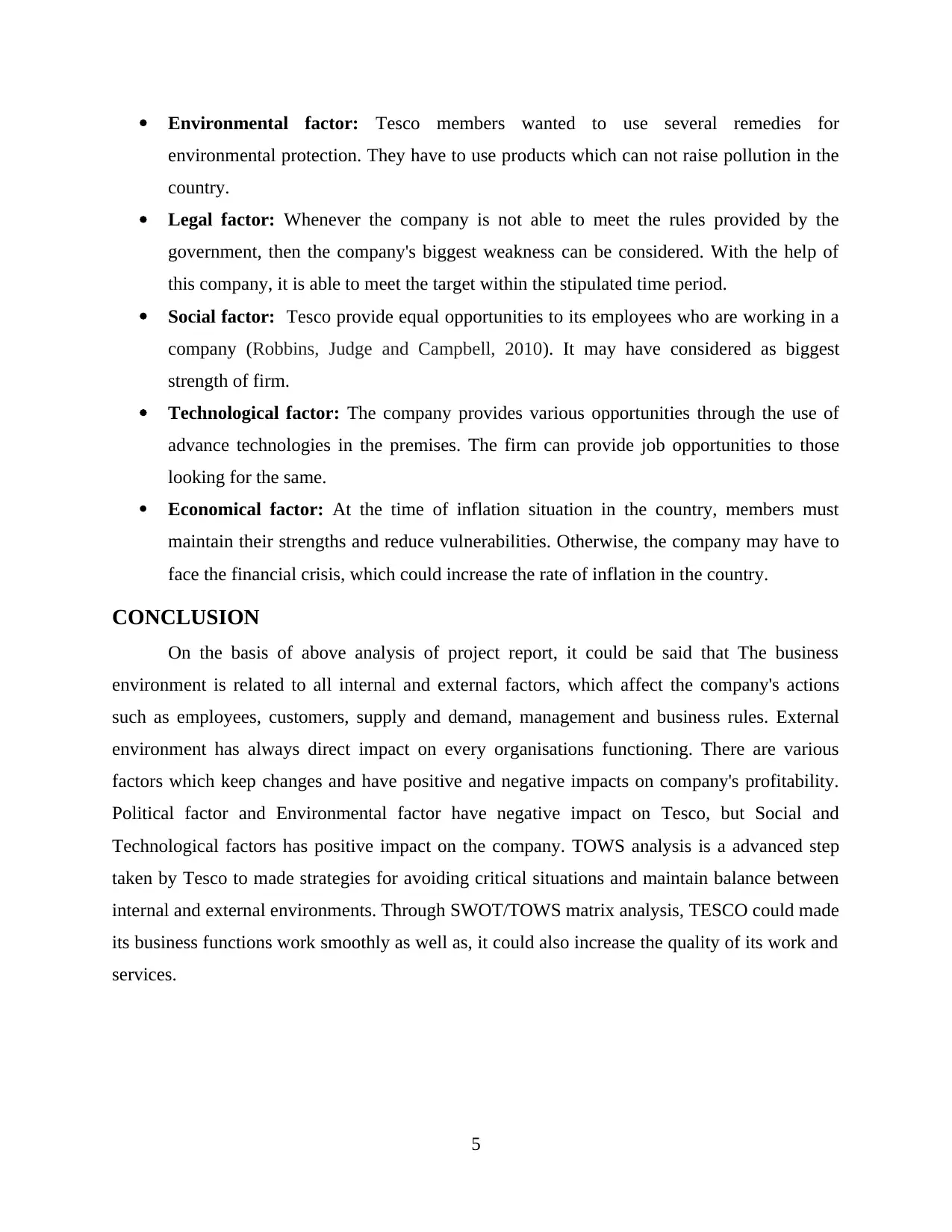
Environmental factor: Tesco members wanted to use several remedies for
environmental protection. They have to use products which can not raise pollution in the
country.
Legal factor: Whenever the company is not able to meet the rules provided by the
government, then the company's biggest weakness can be considered. With the help of
this company, it is able to meet the target within the stipulated time period.
Social factor: Tesco provide equal opportunities to its employees who are working in a
company (Robbins, Judge and Campbell, 2010). It may have considered as biggest
strength of firm.
Technological factor: The company provides various opportunities through the use of
advance technologies in the premises. The firm can provide job opportunities to those
looking for the same.
Economical factor: At the time of inflation situation in the country, members must
maintain their strengths and reduce vulnerabilities. Otherwise, the company may have to
face the financial crisis, which could increase the rate of inflation in the country.
CONCLUSION
On the basis of above analysis of project report, it could be said that The business
environment is related to all internal and external factors, which affect the company's actions
such as employees, customers, supply and demand, management and business rules. External
environment has always direct impact on every organisations functioning. There are various
factors which keep changes and have positive and negative impacts on company's profitability.
Political factor and Environmental factor have negative impact on Tesco, but Social and
Technological factors has positive impact on the company. TOWS analysis is a advanced step
taken by Tesco to made strategies for avoiding critical situations and maintain balance between
internal and external environments. Through SWOT/TOWS matrix analysis, TESCO could made
its business functions work smoothly as well as, it could also increase the quality of its work and
services.
5
environmental protection. They have to use products which can not raise pollution in the
country.
Legal factor: Whenever the company is not able to meet the rules provided by the
government, then the company's biggest weakness can be considered. With the help of
this company, it is able to meet the target within the stipulated time period.
Social factor: Tesco provide equal opportunities to its employees who are working in a
company (Robbins, Judge and Campbell, 2010). It may have considered as biggest
strength of firm.
Technological factor: The company provides various opportunities through the use of
advance technologies in the premises. The firm can provide job opportunities to those
looking for the same.
Economical factor: At the time of inflation situation in the country, members must
maintain their strengths and reduce vulnerabilities. Otherwise, the company may have to
face the financial crisis, which could increase the rate of inflation in the country.
CONCLUSION
On the basis of above analysis of project report, it could be said that The business
environment is related to all internal and external factors, which affect the company's actions
such as employees, customers, supply and demand, management and business rules. External
environment has always direct impact on every organisations functioning. There are various
factors which keep changes and have positive and negative impacts on company's profitability.
Political factor and Environmental factor have negative impact on Tesco, but Social and
Technological factors has positive impact on the company. TOWS analysis is a advanced step
taken by Tesco to made strategies for avoiding critical situations and maintain balance between
internal and external environments. Through SWOT/TOWS matrix analysis, TESCO could made
its business functions work smoothly as well as, it could also increase the quality of its work and
services.
5
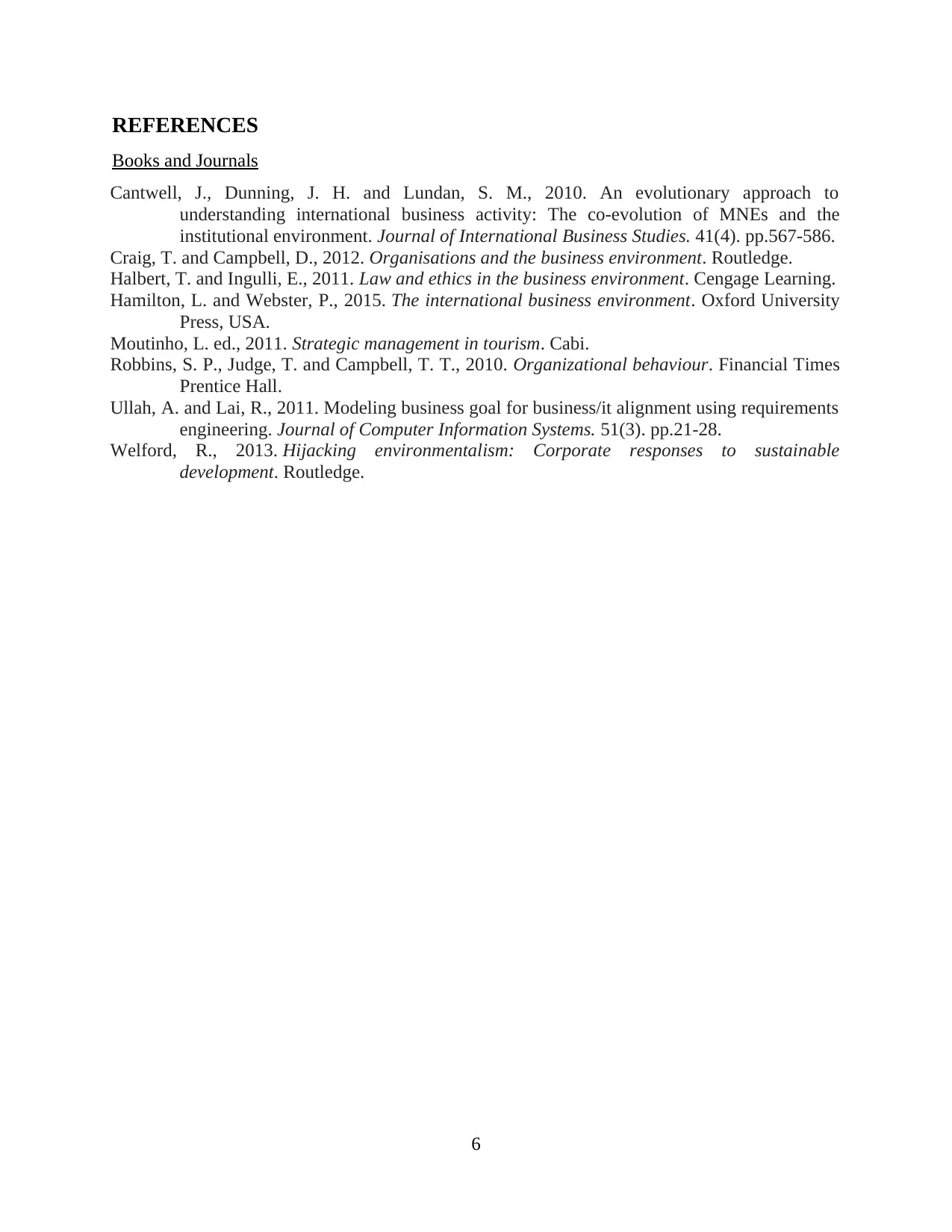
REFERENCES
Books and Journals
Cantwell, J., Dunning, J. H. and Lundan, S. M., 2010. An evolutionary approach to
understanding international business activity: The co-evolution of MNEs and the
institutional environment. Journal of International Business Studies. 41(4). pp.567-586.
Craig, T. and Campbell, D., 2012. Organisations and the business environment. Routledge.
Halbert, T. and Ingulli, E., 2011. Law and ethics in the business environment. Cengage Learning.
Hamilton, L. and Webster, P., 2015. The international business environment. Oxford University
Press, USA.
Moutinho, L. ed., 2011. Strategic management in tourism. Cabi.
Robbins, S. P., Judge, T. and Campbell, T. T., 2010. Organizational behaviour. Financial Times
Prentice Hall.
Ullah, A. and Lai, R., 2011. Modeling business goal for business/it alignment using requirements
engineering. Journal of Computer Information Systems. 51(3). pp.21-28.
Welford, R., 2013. Hijacking environmentalism: Corporate responses to sustainable
development. Routledge.
6
Books and Journals
Cantwell, J., Dunning, J. H. and Lundan, S. M., 2010. An evolutionary approach to
understanding international business activity: The co-evolution of MNEs and the
institutional environment. Journal of International Business Studies. 41(4). pp.567-586.
Craig, T. and Campbell, D., 2012. Organisations and the business environment. Routledge.
Halbert, T. and Ingulli, E., 2011. Law and ethics in the business environment. Cengage Learning.
Hamilton, L. and Webster, P., 2015. The international business environment. Oxford University
Press, USA.
Moutinho, L. ed., 2011. Strategic management in tourism. Cabi.
Robbins, S. P., Judge, T. and Campbell, T. T., 2010. Organizational behaviour. Financial Times
Prentice Hall.
Ullah, A. and Lai, R., 2011. Modeling business goal for business/it alignment using requirements
engineering. Journal of Computer Information Systems. 51(3). pp.21-28.
Welford, R., 2013. Hijacking environmentalism: Corporate responses to sustainable
development. Routledge.
6
⊘ This is a preview!⊘
Do you want full access?
Subscribe today to unlock all pages.

Trusted by 1+ million students worldwide
1 out of 9
Related Documents
Your All-in-One AI-Powered Toolkit for Academic Success.
+13062052269
info@desklib.com
Available 24*7 on WhatsApp / Email
![[object Object]](/_next/static/media/star-bottom.7253800d.svg)
Unlock your academic potential
Copyright © 2020–2025 A2Z Services. All Rights Reserved. Developed and managed by ZUCOL.





